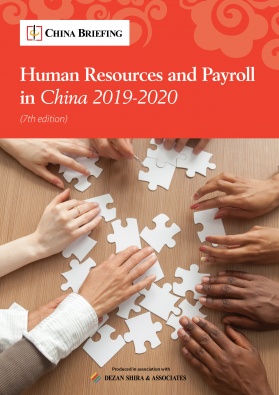Strategies for Managing Enterprise Downsizing and Salary Reduction in China After COVID-19
We discuss the legal options and risks involved for HR managers when strategizing their company’s enterprise downsizing and salary reduction plans in China in the wake of COVID-19.
By Allan Xu, Chenchen Liu
Edited by Zoey Zhang
As the ongoing COVID-19 pandemic sweeps the world, many enterprises are facing financial and operational hiccups due to the economic fallout. Many companies have been forced to rethink their human resource management, to ensure the survival and long-term sustainable development of the enterprise.
Adjusting the internal organization structure and compensation system may effectively optimize human resource (HR) allocation, conserve cash flow, and demonstrate a sound stewardship of a corporate entity.
However, tasks involved in these adjustments, such as downsizing and salary reduction, are not routine for HR teams. Inexperienced HR managers may mishandle the pay cuts or layoffs and expose the firm to legal risks.
To help HR managers, this article offers a snapshot of strategies for effectively managing enterprise downsizing and salary reduction in the wake of COVID-19, keeping in mind the relevant labor laws and latest regulations, employee severance and compensation issues, and legal risks.
Strategies for managing salary adjustment
Position transfer and salary adjustment
Based on certain grounds, employers may consider adjusting the position and, accordingly, the salary and wages of an employee.
Article 40 in the Labor Contract Law of the People’s Republic of China (PRC) implies that the employer may be able to transfer an employee’s position with corresponding adjustments to the person’s salary and wages, if the employee is found incapable of performing the job duties, or if the employee suffers from an illness or a non-work-related injury and is unable to undertake the original job duties following the completion of the stipulated medical treatment period.
However, it is important to note that this operation needs to be exercised with particular caution, to avoid possible labor litigation, which may put the employer at a disadvantage.
The employer is well advised to strictly follow legal procedures and make sure the operation complies with the local regulations. For example, the employer should carry out rounds of assessment for the employee’ performance in different positions and retain sufficient evidence of the rationality of job transfers and salary adjustments. To reduce the legal risks, it is advised to consult with a local legal professional.
Salary adjustment amid the COVID-19 pandemic
During the COVID-19 pandemic, when a company has ceased operations for reasons not related to its employees – generally speaking, the employer must still pay the wages to the employee as normal during the first wage payment period (normally one month), regardless of whether the employee works or not. However, where such a suspension of operation continues for more than one wage payment period, the employer has a right to adjust employees’ wages in line with the relevant local wage payment provisions depending on whether the employee provides normal labor or not (Article 12 of the Interim Provisions on Wage Payments).
During this special period, the employer is entitled to negotiate with the employees to change the contents of their labor contracts, such as reducing the salary and working hours. Of course, changes to a labor contract should be made in writing. Besides, the employer can also contemplate adjusting the staff compensation system upon equal negotiation with labor unions and employee representatives.
Legally reducing labor costs
In addition to the above strategies, there are other legal ways to help reduce labor costs during a pandemic.
- Making use of annual leave, welfare leave, and compensatory leave – during the COVID-19 pandemic, enterprises that do not meet the remote working conditions are allowed to negotiate with their employees on the priority to take various kinds of paid annual leave or welfare leave.
- Adjusting working hours or adopting work shifts – companies can also contemplate reducing the working hours, or arranging shifting for employees, so that employees’ wage can be adjusted accordingly through negotiation. If the standard working hour system is not applicable to the enterprise, it can apply to the local human resources and social security bureau for adopting other working hour systems, such as comprehensive working hour system and non-fixed working hour system.
- Taking advantage of the employee’s salary structure – companies might as well adjust employees’ salary structure. For instance, the employer may adjust the variable performance salary, bonus, commission, or allowance – according to the actual working conditions of the employee through mutual negotiation.
- Negotiating employees’ working hours in a remote working environment – the enterprise may establish a telecommuting system during an epidemic. Under the system, the employer can negotiate with the employees on the standard of working hours and pay the employee by the effective hours the employees put in their work.
- Deferring salary payment – due to the force majeure, difficulties in production and operation, or other reasons, the employer may defer the salary payment during a stipulated grace period based on local wage payment regulations.
Strategies for managing enterprise downsizing
During a pandemic, layoffs are likely to occur under different scenarios due to the downward economic pressure and major environmental changes.
For example, a company may encounter difficulties in business operations, such as cash flow difficulty and insolvency. It may also start internal reorganization when its operation and production in some specific areas has been affected by the pandemic.
Besides, the pandemic may possibly bring a reshuffle to a company’s online and offline business chains, forcing the company to adjust its business model or even lead to a company closure.
However, it is important to note that the rescission of a labor contract should comply with the provisions of the Labor Contract Law of PRC. The reasons and procedures for rescission must follow the law and should not be determined by the employer itself or agreed upon by both parties.
Major changes in objective conditions
Companies might be able to conduct mass layoffs where there are ‘major changes in objective conditions’ (Article 40 of Labor Contract Law).
However, the law does not give a clear definition of ‘major changes in objective’. Typically, the objective circumstances must undergo significant changes, and as a result the labor contract can no longer be performed. For example, the post was eliminated due to a merger and acquisition (M&A) or company reorganization.
Employers would be wise to consult a legal professional to determine if this is an option for their situation.
Economic dismissal
Economic dismissal is another way, but the applicability of this strategy is quite restrictive.
Economic dismissal can only be conducted under four circumstances – the employer undergoes enterprise restructuring under the Enterprise Bankruptcy Law; the employer meets serious difficulties in business production and operation; the employer undergoes a change of production, significant technological reform, or change of operation mode, and upon variation of labor contracts, there is still a need for layoffs; or the objective circumstances have undergone significant changes and as a result the labor contract can no longer be performed. (Article 41 of Labor Contract Law)
Besides, the Chinese Labor Contract Law has strict requirements on the number of redundancies and procedural requirements for economic dismissal. Companies must carefully interpret the key points of the law or consult lawyers before using this method.
Furthermore, certain types of employees cannot be laid off during an economic dismissal by law, including employees with work injury or occupational illness, employees in a medical treatment, female employees in the pregnancy, maternity, or breastfeeding period, or employees who have worked for more than 15 consecutive years and will attain the statutory retirement age in less than five years.
Company dissolution
There can be mass layoffs, wherever the company’s business license is revoked, the company is ordered to close down, or the employer has decided to dissolve the enterprise prematurely.
But at this point, the employer should pay special attention to arrange certain special employees and make sure the relevant rights and interests of laid-off employees are properly handled, to avoid labor disputes. For example, some employees with a work-related injury may not be able to enjoy the insurance benefits after the closure of the company.
Severance and compensation payment
As long as the employee has not violated the company organizational policy or made a serious mistake, employers are required to pay severance and compensation to employees based on their years of service. This means, employers should pay one month’s average compensation (including gross salary, annual bonus, other subsidies) multiplied by the number of years the employee worked for the enterprise. An additional one month’s compensation can be paid in lieu of 30 days’ notice to the employee.
The ‘one-month average compensation’ is calculated based on the average of the past 12 months before termination.
If the employee has worked six months or more within a year, the employee will be entitled average month compensation; if the employee has worked less than six months, the employee will be entitled to half of the average month compensation. However, the compensation’s calculation base is capped at three times of the average local monthly compensation.
To be noted, where an employer violates the provisions of labor laws to terminate an employee, if the employee decides to leave the company, the employer may need to pay two months’ average compensation as severance fee; if the employee wants to resume labor relations, the company must continue to honor the original contract.
Legal risks and reminders
Whenever an enterprise contemplates a layoff, it must consider the risks of running afoul of the labor laws, which could trigger labor disputes and lawsuits filed by employees. At sensitive times, mass layoffs can also leave the enterprise subject to increased supervision by relevant local government departments. So, in special cases, the enterprise is advised to obtain the approval of government departments in advance.
In addition, companies should pay attention to employees in key positions. Some employees may hold evidence of wrongdoing of the company and report the incompliance to relevant government departments; this could trigger a government investigation process that will drag the enterprise’s progress in downsizing.
Some local business executives may keep important enterprise documents, company chops, the U key of the bank, or financial information, and refuse to return them back. This dilemma often occurs in joint ventures (JV) and wholly owned foreign enterprises (WOFE), when their Chinese partner or subsidiary’s executive refuses to cooperate. However, reapplying for licenses and company chops takes far more time. Thus, it is suggested that the parent company entrust a third party to supervise and manage the risk of the local company, and keep the important business license, seal, financial data and other important information of the departed manager.
Employers should maintain an open and transparent approach to the implementation of the layoff plan and go through all legal procedures with professional guidance. If you have any further query about the applicable laws and regulations, legal procedures, implementation strategies of above-mentioned solutions, please feel free to contact us at china@dezshira.com.
About Us
China Briefing is written and produced by Dezan Shira & Associates. The practice assists foreign investors into China and has done so since 1992 through offices in Beijing, Tianjin, Dalian, Qingdao, Shanghai, Hangzhou, Ningbo, Suzhou, Guangzhou, Dongguan, Zhongshan, Shenzhen, and Hong Kong. Please contact the firm for assistance in China at china@dezshira.com.
We also maintain offices assisting foreign investors in Vietnam, Indonesia, Singapore, The Philippines, Malaysia, Thailand, United States, and Italy, in addition to our practices in India and Russia and our trade research facilities along the Belt & Road Initiative.
- Previous Article Hongkongs US-gebundene Exporte sollen als “Made in China” gekennzeichnet werden: Was bedeutet das?
- Next Article Hainan Medical Tourism Zone: What’s in the Integration and Innovation Reform Plan?







